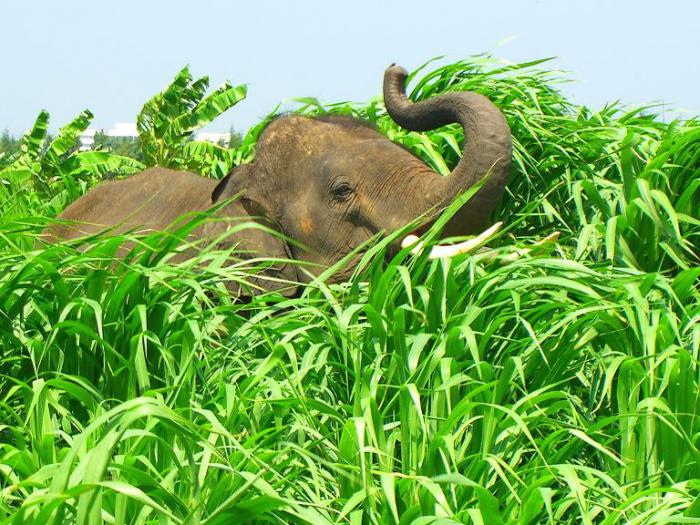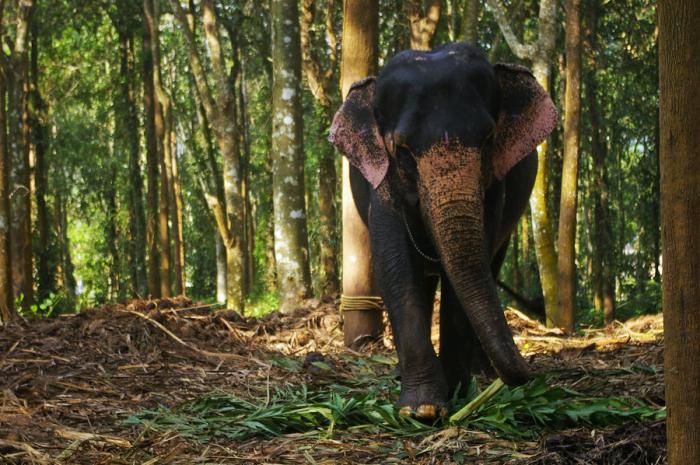If we were not familiar with elephants from early childhood, perhaps we would take these giant animals for fantastic creatures. Do you know any other mammals that can eat with their nose, uproot trees and even lift people into the air? And the additional fact that during the life of the elephants molars are updated several times would be doubtful and surprising.

Today it can be argued that much of what was written in old books about elephants or which has come down to us in ancient legends is at variance with reality. Of course, these animals never lived to be two hundred years old, they never fought dragons. But, being mammals from ancient times connected with humans and uniquely adapted to living conditions, elephants are extremely interesting. For example, many people want to know what these giants eat and are amazed that such huge animals are real vegetarians. In the article we will tell you in detail about what elephants eat, in what quantities they consume food and how it is extracted.
Diet
Everyone knows that at present there are two types of elephants - Indian and African. They are so different from each other that they can be considered as representatives of different genera. So the diet of animals depends on the region of habitat. For example, elephants living in southern India like to chew ficus leaves, while those in Zimbabwe prefer to consume grass like cattail and papyrus. What elephants eat also depends on the season: in rains and droughts, the diet will be different.
Food in captivity
What do elephants eat at the zoo? Here they get a huge amount of greens and hay. The daily diet also includes root crops, several stale rolls, carrots, heads of cabbage, apples. Elephant's favorite treat is, of course, bananas. Cookies and bread are also popular. And how proboscis love sweets! No less than people. And just like a person, an elephant runs the risk of overeating sweets and getting fat, resulting in health problems. The behavior of the animal becomes unnatural: it walks staggering along the fence and only waits for the next visitors to bring the long-awaited treat.
Elephants living in the wild move a lot. In search of the amount of food that is enough for well-being, mammals travel considerable distances every day. In the zoo, animals do not have the ability to move so actively, and as a result they have problems with digestion. Elephants are fed five to six times a day, sometimes fruits and vegetables are cut and mixed with hay, scattered around the aviary. This is done in order to occupy the proboscis in search of tasty pieces and thus, firstly, reduce the rate of absorption of food, and secondly, entertain.
How much does an elephant eat per day
A daily adult animal consumes approximately 250 kilograms of food and 100-150 liters of fluid. For clarity, we will talk about what elephants eat in the Moscow Zoo. A large proportion of their daily diet is made up of tree branches collected in brooms. Most often, willow branches are used, and one elephant absorbs on average forty willow brooms (about six to eight kilograms) per day. Thirty kilograms of grass and hay are also laid daily on the proboscis, and a few kilos of straw as an additive. The cereal part of the menu consists of oats (one to two kilograms), oatmeal (four to five kilograms), bran (one kilogram), bread (several kilograms). From juicy feed elephants laid fruits: pears, apples, bananas (eight kilograms). And vegetables: carrots (fifteen kilograms), cabbage (three kilograms), beets (four to five kilograms). In summer, the menu includes watermelons. It is noteworthy that mammals do not eat whole cabbage and watermelons, but first they put them on the floor and gently crush them with their feet. Animals also consume potatoes, but only in boiled form, and sometimes they are even given a little onion. Here, perhaps, is the whole list of what elephants eat in the zoo.
Features of free nutrition
Males consume up to 170 kilograms of fresh plants per day, while females are content with about 150 kilograms. Typically, proboscis prefer that vegetation, which is located at a height of not more than two meters. Above the elephant will reach the trunk only if the treat is really worth it, if necessary, it can stand on its hind legs. Often young males, just for fun, cut small trees.
As we have said, what elephants eat in Africa, and what in India, varies greatly. For example, in savannah proboscis from Uganda, up to 88 percent of the daily diet is grass, and Indian mammals consume mainly leaves, although they also do not mind treating themselves with tasty tubers and roots. The plant, as a rule, uproots an elephant, shakes the ground on a leg or tusk and sends a treat to the mouth.
Food absorption process
We already told that elephants eat, now I want to talk about how they do it. Hard food animals are crushed with only four teeth. In proboscis, solid enamel ribs on the teeth are transverse, so they move the lower jaw back and forth, and not from side to side, such as cows. Elephants chew parts of plants or wood quite carefully to absorb nutrients to the maximum benefit. The intestines of animals has a length of about 35 meters, and this is much shorter than that of representatives of cattle. Therefore, proboscis digest any food no matter, and wood even more so. Approximately half eaten per day remains undigested.

What do elephants eat in case of food shortage? They peel the trees, absorbing the bark, causing great damage and make it impossible for people to restore the forest in these places. But nothing can be done, the animals simply have no choice, and if they spare the trees, they will die themselves. But thanks to what the African elephant eats , or rather, how it does it, it is possible to preserve and spread many types of plants. The fact is that savannah proboscis transfer eatable seeds to places with a good amount of light, where they receive excellent conditions for germination. Experts estimate that if it were not for the elephants, 36 species of plants would disappear in Africa.
Fluid requirement
Proboscis drink a lot (as already noted, up to 150 liters daily). If, during a drought, all available water sources dry out, the animals go in search of life-giving moisture. With a trunk and tusks in the dried up riverbeds, they dig holes up to a meter deep, where groundwater slowly flows. Other inhabitants of the savannah, who are not able to get a drink in this way, patiently wait for the elephants to quench their thirst, and then they themselves drink plenty. Thus, proboscis help them survive the drought. However, it also happens that efforts to find water do not bring the desired result, and then hundreds or even thousands of animals die from dehydration.
Chasing food
Few people know that elephants eat for 17-19 hours a day. That is how much time they need to satisfy the need for food. In the tropics, where the days are shorter than ours, the trunk for proper nutrition even has to use a few hours at night. Animals wait for the heat of the day in water or in the shade, so as not to overheat, and therefore lose precious time that they could spend on a meal. In drought, elephants have to cross large distances every day between a water body and pasture; they are constantly moving around the territory.
Finally
Adult proboscis has no enemies except humans. The biggest danger for them is the narrowing of the habitat. Every day, animals need a lot of food, which means they need large areas where they could feed themselves. But these lands are necessary for people. Therefore, elephants now live mostly in nature reserves.